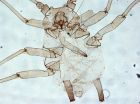(Press-News.org) Collaborative research at the University of Guam has people asking: "What IS a species" and entomologists wondering about the relationship between an insect species and the host plant or plants it feeds on.
Western Pacific Tropical Research Center (WPTRC) entomologist Ross Miller has been studying aphids for years and this work has brought him in contact with entomologists in Canada and the US mainland. Aphid systemetist Robert Foottit, DNA expert Eric Maw and aphid authority Keith Pike have been working with Miller on the identification of aphids, particularly the dreaded banana aphid, Pentalonia nigronervosa for nearly ten years. The banana aphid is of interest to researchers and growers worldwide due to its role in transmitting banana bunchy top virus (BBTV).
Using DNA sequencing, this shared project has discovered genetic differences in aphids that resemble banana aphids, but feed on different plants. In their recently published paper, Zootaxa 2358: 25-38 (2010), the authors present data supporting the idea that Pentalonia caladii may be a species in its own right instead of a form of Pentalonia nigronervosa.
Working with "banana aphids" collected from banana, heliconia and ginger plants gathered throughout Micronesia, Hawaii, Florida, and Australia the researchers discovered, through genetic bar coding, that aphids living on gingers and heliconias are genetically different than those living on banana plants. Their findings are definitive enough to warrant reclassification of P. caladii. "This research has important ramifications in the biological control of banana aphids to prevent the spread of BBTV since much of the previous work on banana aphid may have actually involved P. caladii instead of P. nigronervosa," says Miller. Researchers may find that aphids living on ginger and heliconia plants may pose no threat to banana plants if they are unable to harbor and transmit the virus.
As is often the case with significant findings, these results call for additional research efforts. It will be interesting to determine which species of aphid is found on other Micronesian islands and whether or not both species are equally capable of transmitting BBTV.
Currently, BBTV is found only on Guam in Micronesia and the Hawaiian islands. Miller and his lab, working with UOG plant pathologist George C. Wall, have received T-STAR funding to verify the host range of the two aphids and to examine their vectoring capabilities.
INFORMATION:
Identity theft by aphids
2011-01-20
ELSE PRESS RELEASES FROM THIS DATE:
Stroke rate rises for patients with HIV infection
2011-01-20
While the overall hospitalization rate for stroke has declined in recent years, the numbers have jumped dramatically for patients infected with human immunodeficiency virus (HIV), suggesting they may be up to three times more likely to suffer a stroke than people uninfected by the virus that causes AIDS.
In a paper published in the Jan. 19 online issue of Neurology, Bruce Ovbiagele, MD, professor of neurosciences at the University of California, San Diego School of Medicine and Avindra Nath, MD, of Johns Hopkins University, reviewed a national dataset of all hospital ...
Spike reported in number of people with HIV having a stroke
2011-01-20
ST. PAUL, Minn. – New research suggests that people infected with human immunodeficiency virus (HIV) may be up to three times more likely to have a stroke compared to those not affected with HIV. The study is published in the January 19, 2011, online issue of Neurology®, the medical journal of the American Academy of Neurology.
"Our findings showed that stroke hospitalizations in the United States decreased by seven percent in the general population within the last decade while stroke hospitalizations for people with HIV rose 67 percent," said Bruce Ovbiagele, MD, MSc, ...
Bedbug genetic study finds possible pesticide-resistance genes
2011-01-20
Ohio State University entomologists have conducted the first genetic study of bedbugs, paving the road to the identification of potential genes associated with pesticide resistance and possible new control methods for the troublesome insect, whose sudden resurgence in the United States has led to a public health scare.
The discovery was reported Jan. 19 in the online journal PLoS ONE.
"While bedbugs are poised to become one of the major household pests across the United States in the coming years, we know very little about their genetic makeup and their mechanisms of ...
Hotspots tamed by BEAST
2011-01-20
The secrets behind the mysterious nano-sized electromagnetic "hotspots" that appear on metal surfaces under a light are finally being revealed with the help of a BEAST. Researchers at the U.S. Department of Energy (DOE)'s Lawrence Berkeley National Laboratory (Berkeley Lab) have developed a single molecule imaging technology, dubbed the Brownian Emitter Adsorption Super-resolution Technique (BEAST), that has made it possible for the first time to directly measure the electromagnetic field inside a hotspot. The results hold promise for a number of technologies including ...
UCSF team views genome as it turns on and off inside cells
2011-01-20
UCSF researchers have developed a new approach to decoding the vast information embedded in an organism's genome, while shedding light on exactly how cells interpret their genetic material to create RNA messages and launch new processes in the cell.
By combining biochemical techniques with new, fast DNA-sequencing technology and advanced computer technology, the team was able to examine with unprecedented resolution how a cell converts DNA into RNA – a molecular cousin of DNA that is used in the process of creating proteins that govern most biological functions. And they ...
The Orion nebula: Still full of surprises
2011-01-20
The Orion Nebula, also known as Messier 42, is one of the most easily recognisable and best-studied celestial objects. It is a huge complex of gas and dust where massive stars are forming and is the closest such region to the Earth. The glowing gas is so bright that it can be seen with the unaided eye and is a fascinating sight through a telescope. Despite its familiarity and closeness there is still much to learn about this stellar nursery. It was only in 2007, for instance, that the nebula was shown to be closer to us than previously thought: 1350 light-years, rather ...
Cancer scientists discover genetic diversity in leukemic propagating cells
2011-01-20
(Toronto, Canada – January 20, 2011) – Cancer scientists led by Dr. John Dick at the Ontario Cancer Institute (OCI) and collaborators at St Jude Children's Research Hospital (Memphis) have found that defective genes and the individual leukemia cells that carry them are organized in a more complex way than previously thought.
The findings, published today in Nature (DOI:10.1038/nature09733), challenge the conventional scientific view that cancer progresses as a linear series of genetic events and that all the cells in a tumour share the same genetic abnormalities and ...
How much sex is enough?
2011-01-20
Society has long debated the contrasting advantages of monogamy and promiscuity and, in western society at least, the long term benefits of monogamy have in general won out. However new research published in BioMed Central's open access journal BMC Evolutionary Biology shows that sperm from polygamous mice are better competitors in the race for fertilisation.
Dr Renée Firman at the Centre for Evolutionary Biology, University of Western Australia, has used house mice to show that sperm from rival males compete to fertilise females and that, over several generations, polygamy ...
Creating simplicity: How music fools the ear
2011-01-20
What makes music beautiful? The best compositions transcend culture and time – but what is the commonality which underscores their appeal? New research published in BioMed Central's open access journal BMC Research Notes suggests that the brain simplifies complex patterns, much in the same way that 'lossless' music compression formats reduce audio files, by removing redundant data and identifying patterns.
There is a long held theory that the subconscious mind can recognise patterns within complex data and that we are hardwired to find simple patterns pleasurable. Dr ...
Quality improvement intervention for ICUs results in increased use of evidence-based care practices
2011-01-20
A multifaceted quality improvement intervention that included education, reminders and feedback through a collaborative telecommunication network improved the adoption of evidenced-based care practices in intensive care units at community hospitals for practices such as preventing catheter-related bloodstream infections and ventilator-associated pneumonia, according to a study that will appear in the January 26 issue of JAMA. The study is being published early online to coincide with its presentation at the annual meeting of the Society of Critical Care Medicine.
Despite ...


